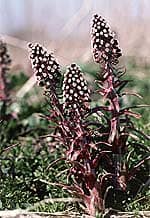Life Extension Magazine®
Every year, nearly a million people in the United States end up in the emergency room seeking relief from debilitating migraine pain.1 Severe migraine headaches remain an unresolved medical issue for millions of people despite the availability of powerful drugs and specialty migraine clinics. For most people, taming their migraines is an ongoing series of trial and error events using various medications and stress-reduction therapies. For some, however, the very drugs taken to resolve migraine may actually create a chronic migraine condition.2 Alarming studies have even shown that those who suffer from a certain type of migraine are at risk for life-threatening cardiovascular disease.3 Given the severity of the problem, alternative methods are urgently needed to deal with this serious health issue. Clinical studies from Germany have positively confirmed that an herbal extract known as butterbur (Petasites hybridus) may cut the frequency of migraine headaches by up to 50% in long-term migraine sufferers.4-7 Sadly, many Americans still remain unaware of this unique supplement, which has been shown to be as effective as many prescription medications in preventing migraine with far fewer side effects. Migraines versus HeadachesMigraines are distinguished from everyday headaches such as tension headaches by their intensity and duration. “The typical headache of migraine is throbbing or pulsatile,” notes Jasvinder Chawla, MBBS, MD, assistant professor of neurology at the Loyola University of Chicago. The pain usually starts on one side of the head, becoming more generalized, and typically lasts from several hours to a day, Dr. Chawla adds. Pain intensity may be moderate to severe and aggravated by physical activity, prompting the patient to remain still as it intensifies.8 Migraine episodes are often accompanied by dizziness, nausea, and vomiting. The patient may also be very sensitive to light, often experiencing neurological effects known as “aura” that precede the headache by as much as an hour.9 These effects produce visual symptoms such as flashing lights, bright spots, blind spots, and blurry vision.10-12 Even in the absence of aura, many sufferers go through a “prodrome” or preliminary period in which feelings of elation or intense energy, craving for sweets, thirst, drowsiness, irritability, or depression serve as a warning that a migraine is on the way.11
What Triggers a Migraine?
Migraines can be triggered by stress, tension, anxiety, and insufficient food or sleep. Intense sensory stimuli such as bright lights, loud noise, cigarette smoke, and strong odors may also precipitate migraine in susceptible individuals. In addition, specific food products can bring on migraine such as chocolate, aged cheeses, wine, beer, caffeine, and monosodium glutamate. Because migraines can be triggered by fluctuations in estrogen, women may experience episodes immediately before menstruation or if they start oral contraceptives or conventional, non-bioidentical hormone-replacement therapy.11,12 Research indicates that abnormal electrical changes across the brain can help trigger migraine. These changes may be linked with low levels of magnesium and high levels of calcium and glutamate.13 First, there is a wave of neuronal excitation that is followed by a wave of depression in a phenomenon known as cortical spreading depression. These changes in electrical activity passing through nerve cells stimulate the release of peptides and other proinflammatory substances that irritate nerves causing pain particularly in the trigeminal system, which conveys sensory information for the face and much of the head.8,13 It is unknown why some individuals are more susceptible to migraine than others, but researchers believe that genetic factors play a part. If both of your parents were migraine sufferers, your own risk of migraines is doubled.11 Overuse of Pain Remedies Can Lead to Chronic HeadachesWhen migraine strikes, conventional physicians often recommend nonsteroidal anti-inflammatory drugs (NSAIDs) such as ibuprofen or aspirin. When these over-the-counter remedies are not enough, doctors often prescribe medications such as Imitrex®. These drugs are not risk-free. Common side-effects include nausea, dizziness, muscle weakness, and even a slightly elevated risk of stroke or heart attack.11 Drowsiness and rapid heart rate are commonly reported with Imitrex®-like drugs and up to 40% of people experience headache recurrence within 24 hours after taking them.14 While prescription medications can relieve acute migraine pain, their excessive use (generally considered as more than two to three days a week on a regular basis) can increase susceptibility to chronic headaches. The result is a tightening spiral of dependency on pain medications.2,9 This is where migraine-prevention strategies—both prescription and natural—can play an important role in breaking the cycle of pain.
Prescription Migraine-Prevention Strategies
A wide range of prescription migraine-preventives are available, including antidepressants such as amitriptyline, beta blockers such as propranolol, and anti-seizure drugs such as divalproex sodium, but their effectiveness is unpredictable. They are also likely to induce unpleasant side effects. Amitriptyline is well known for its tendency to cause weight gain; propranolol is likely to cause fatigue; and divalproex sodium can increase the risk of birth defects in women of child-bearing age—the population most likely to suffer from migraines in the first place.15 In addition, doctors often need to try many of these drugs on a trial-and-error basis to find one that is tolerable and effective, a process that can take months or even years. Clearly, a safer and better approach to migraine prevention is greatly needed. The Natural Alternative: ButterburStudies suggest that a standardized extract of butterbur (Petasites hybridus) is a powerful migraine-preventive agent.4,16 Butterbur has been used for more than 2,000 years for conditions ranging from gastric disorders to allergies.16-19 A specialized butterbur root extract has been available in Germany as a prescription remedy since 1988. More than half a million German citizens have used this remarkable plant extract for health concerns such as migraine prevention and allergies.18 The good news is that this standardized butterbur extract is now also readily available in the United States as a dietary supplement. Butterbur’s headache-preventive capabilities likely stem from its anti-inflammatory and spasmolytic (muscle-relaxant) effects.17 It contains active components known as isopetasin, oxopetasin, and petasin, which induce smooth muscle relaxation, particularly in cerebral blood vessel walls. Research indicates that petasin inhibits the proinflammatory lipoxygenase (LOX) enzyme, while both petasin and isopetasin exert highly potent anti-inflammatory effects by inhibiting leukotriene synthesis. Butterbur extract has also been reported to inhibit cyclooxygenase-2 (COX-2) activity, which relieves pain and inflammation. In addition, butterbur petasins decrease the intracellular concentration of calcium, thus offsetting calcium-induced vasoconstriction, which also helps explain the herb’s anti-inflammatory and spasmolytic effects.19
Preventing Migraine With Butterbur: the Evidence
The earliest evidence of butterbur’s migraine-preventive power came from a small study conducted in Germany comprising 60 patients, in which a group of 33 adults took 50 mg of standardized butterbur extract twice daily and the remaining group took placebo.16 At the study’s onset, the participants suffered an average of 3.3 migraines each month. After four weeks of treatment, those who supplemented with butterbur averaged just 1.8 migraines per month. After eight weeks, they suffered only 1.3 migraines per month—a 61% decrease. At 12 weeks, the butterbur recipients reported an average of 1.7 migraine attacks per month—a 49% decrease. The total number of headache days per month fell from 3.4 to 1.7 days by the study’s end.16 In another study, researchers split 245 patients into three groups to receive: 75 mg of butterbur extract twice a day, 50 mg of butterbur extract twice a day, or placebo.4 At the end of a four-month treatment period, the patients taking 50 mg of butterbur extract experienced a modest reduction in migraine frequency relative to placebo users. Among those taking the 75 mg dosage, more than two-thirds reported that their incidence of migraine attacks had diminished by at least 50%.4 The results achieved by taking 50-75 mg of standardized butterbur extract twice a day are comparable to the observed benefits of prescription migraine-preventive medications. The added benefit of butterbur is that its safety is far superior to such drugs.4,16 Preventing Migraine in ChildrenMigraine is not only a serious health condition in adults—children’s health can also be adversely impacted by this debilitating condition. An estimated 10% of school-age children suffer from migraine, and half of all migraine sufferers experience their first attack before age 12. Migraine affects boys and girls equally before puberty, but becomes more prevalent in girls in adolescence.9 Children’s migraines are often overlooked because they present with symptoms that are different from adult migraine. Head pain tends to be less pronounced in childhood migraine compared with other symptoms such as nausea, vomiting, abdominal pain, and vertigo. Some childhood migraines may even manifest without head pain.9 Fortunately, butterbur extract shows impressive migraine-preventive effects in children as well as adults. A multicenter, prospective, open-label study examined the migraine-preventive effects of butterbur extract in 108 children and adolescents between the ages of 6 and 17 years who had suffered migraines for at least one year before the study’s onset.7 The participants supplemented with 50-150 mg of standardized butterbur extract, depending on age, for four months. A remarkable 77% reported that the frequency of their migraine attacks decreased by at least 50%. In those who benefitted, attack frequency was reduced by 63%. In addition, butterbur was also well tolerated.7 A recent study showed that music therapy is also effective in preventing migraine in children and that this relaxation therapy may complement butterbur’s ability to keep migraines at bay.20
Additional Strategies For Migraine Prevention
Other nutritional therapies may combine with butterbur’s activity to prevent migraine headaches. Among the best studied and most promising of these are riboflavin (vitamin B2) and ginger. Riboflavin is a B vitamin that is crucial to mitochondrial energy production. Researchers have discovered that patients who suffer from migraines have depleted mitochondrial energy reserves between attacks.21 Riboflavin helps increase neuronal energy production and has been shown to be effective as migraine-preventive therapy.21,22 A randomized trial of 55 migraine sufferers found that those who consumed 400 mg of riboflavin daily for three months experienced a dramatic reduction in migraine headaches. Nearly 60% of those who received riboflavin saw a 50% or greater reduction in the number of migraines per month.22 These findings were confirmed by another study in 23 participants that showed supplementation with 400 mg riboflavin daily reduced headache frequency by 50% at three months, an improvement that persisted at six months. Thanks to riboflavin, participants were also able to decrease their use of prescription migraine remedies.23 Ginger has long been valued for its ability to combat inflammation, nausea, and pain. As such, it is ideally poised for combating the many manifestations of migraine—ranging from head pain to vomiting.24 Importantly, ginger acts effectively in relieving acute symptoms as well as a preventive therapy.24 Scientists have found that ginger works via numerous mechanisms to fight inflammation and pain. Ginger inhibits the proinflammatory cyclooxygenase (COX) and lipoxygenase (LOX) pathways that can contribute to acute and recurrent pain.24 These properties have led researchers to conclude that “ginger may exert abortive and prophylactic effects in migraine without any side effects.”25
Safety of ButterburButterbur root should never be consumed directly from the plant, since it contains compounds called pyrrolizidine alkaloids that have may have hepatotoxic and carcinogenic effects.17 However, extracts that are prepared for human use are processed to remove these alkaloids. An independent evaluation of data gathered from various trials concluded that commercially marketed butterbur root extract is entirely safe for human consumption.26 A standardized butterbur extract has been used by more than half a million German citizens since its introduction in 1988, and the safety data are excellent.18 A dosage of 50-75 mg of standardized butterbur extract twice daily for up to four months has demonstrated efficacy in migraine prevention,17 while 50 mg twice daily has been used in the management of allergic rhinitis.17 No instances of overdose with butterbur have been reported in the scientific literature,17 but anyone who has a known allergy to plants in the Asteraceae family, such as ragweed or daisies, should consume butterbur with caution. ConclusionIndividuals with a history of migraine headaches now have a powerful, clinically proven alternative to risky, high-cost pharmaceutical treatments. Already widely used in Europe to minimize debilitating headaches, butterbur extract—combined with riboflavin and ginger—may also help Americans free themselves from the crippling grasp of recurrent migraines. If you have any questions on the scientific content of this article, please call a Life Extension Wellness Specialist at 1-800-226-2370.
| |||||||||||||||||||
| References | |||||||||||||||||||
| 1. Available at: http://www.headachemeeting.org/press_releases/1016/IVNSAIDforMigraine.pdf. Accessed May 28, 2008. 2. Bigal ME, Rapoport AM, Sheftell FD, Tepper SJ, Lipton RB. Transformed migraine and medication overuse in a tertiary headache centre--clinical characteristics and treatment outcomes. Cephalalgia. 2004 Jun;24(6):483-90. 3. Kurth T, Gaziano JM, Cook NR, et al. Migraine and risk of cardiovascular disease in women. JAMA. 2006 Jul 19;296(3):283-91. 4. Lipton RB, Gobel H, Einhaupl KM, Wilks K, Mauskop A. Petasites hybridus root (butterbur) is an effective preventive treatment for migraine. Neurology. 2004 Dec 28;63(12):2240-4. 5. Grossmann M, Schmidramsl H. An extract of Petasites hybridus is effective in the prophylaxis of migraine. Int J Clin Pharmacol Ther. 2000 Sep;38(9):430-5. 6. Diener HC, Rahlfs VW, Danesch U. The first placebo-controlled trial of a special butterbur root extract for the prevention of migraine: reanalysis of efficacy criteria. Eur Neurol. 2004;51(2):89-97. 7. Pothmann R, Danesch U. Migraine prevention in children and adolescents: results of an open study with a special butterbur root extract. Headache. 2005 Mar;45(3):196-203. 8. Available at: www.emedicine.com/neuro/TOPIC218.HTM#section~Introduction. Accessed May 10, 2008. 9. Available at: www.migraineresearchfoundation.org/AboutMigraine.asp. Accessed May 27, 2008. 10. Available at: www.ninds.nih.gov/disorders/migraine/migraine.htm. Accessed May 8, 2008. 11. Available at: www.mayoclinic.com/print/migraine-headache/DS00120. Accessed May 8, 2008. 12. Available at: www.nlm.nih.gov/medlineplus/ency/article/000709.htm. Accessed May 9, 2008. 13. Silberstein SD. Migraine pathophysiology and its clinical implications. Cephalalgia. 2004;24 Suppl 22-7. 14. Available at: http://www.umm.edu/patiented/articles/ what_specific_drugs_remedies_treating_a_migraine_attack_000097_7.htm. Accessed May 8, 2008. 15. Dodick DW, Silberstein SD. Migraine prevention. Pract Neurol. 2007 Nov;7(6):383-93. 16. Grossmann M, Schmidramsl H. An extract of Petasites hybridus is effective in the prophylaxis of migraine. Int J Clin Pharmacol Ther. 2000 Sep;38(9):430-5. 17. Giles M, Ulbricht C, Khalsa KP, et al. Butterbur: an evidence-based systematic review by the natural standard research collaboration. J Herb Pharmacother. 2005;5(3):119-43. 18. Available at: http://www.medscape.com/viewarticle/496706. Accessed May 22, 2008. 19. Kälin P. The common butterbur (Petasites hybridus)—portrait of a medicinal herb. Forsch Komplementarmed Klass Naturheilkd. 2003 Apr;10 (Suppl 1):41-4. 20. Oelkers-Ax R, Leins A, Parzer P, et al. Butterbur root extract and music therapy in the prevention of childhood migraine: an explorative study. Eur J Pain. 2008 Apr;12(3):301-13. 21. Sándor PS, Afra J, Ambrosini A, Schoenen J. Prophylactic treatment of migraine with beta-blockers and riboflavin: differential effects on the intensity dependence of auditory evoked cortical potentials. Headache. 2000 Jan;40(1):30-5. 22. Schoenen J, Jacquy J, Lenaerts M. Effectiveness of high-dose riboflavin in migraine prophylaxis. A randomized controlled trial. Neurology. 1998 Feb;50(2):466-70. 23. Boehnke C, Reuter U, Flach U, Schuh-Hofer S, Einhäupl KM, Arnold G. High-dose riboflavin treatment is efficacious in migraine prophylaxis: an open study in a tertiary care centre. Eur J Neurol. 2004 Jul;11(7):475-7. 24. No authors. Zingiber officinale (ginger). Monograph. Altern Med Rev. 2003 Aug;8(3):331-5. 25. Mustafa T, Srivastava KC. Ginger (Zingiber officinale) in migraine headache. J Ethnopharmacol. 1990 Jul;29(3):267-73. 26. Danesch U, Rittinghausen R. Safety of a patented special butterbur root extract for migraine prevention. Headache. 2003 Jan;43(1):76-8. 27. Schapowal A. Randomised controlled trial of butterbur and cetirizine for treating seasonal allergic rhinitis. BMJ. 2002 Jan 19;324(7330):144-6. 28. Schapowal A. Butterbur Ze339 for the treatment of intermittent allergic rhinitis: dose-dependent efficacy in a prospective, randomized, double-blind, placebo-controlled study. Arch Otolaryngol Head Neck Surg. 2004 Dec;130(12):1381-6. 29. Lee DK, Gray RD, Robb FM, Fujihara S, Lipworth BJ. A placebo-controlled evaluation of butterbur and fexofenadine on objective and subjective outcomes in perennial allergic rhinitis. Clin Exp Allergy. 2004 Apr;34(4):646-9. 30. Käufeler R, Polasek W, Brattström A, Koetter U. Efficacy and safety of butterbur herbal extract Ze 339 in seasonal allergic rhinitis: postmarketing surveillance study. Adv Ther. 2006 Mar-Apr;23(2):373-84. 31. Danesch UC. Petasites hybridus (Butterbur root) extract in the treatment of asthma—an open trial. Altern Med Rev. 2004 Mar;9(1):54-62. 32. Lin LH, Huang TJ, Wang SH, et al. Bronchodilatory effects of S-isopetasin, an antimuscarinic sesquiterpene of Petasites formosanus, on obstructive airway hyperresponsiveness. Eur J Pharmacol. 2008 Apr 28;584(2-3):398-404. 33. Shimoda H, Tanaka J, Yamada E, et al. Anti type I allergic property of Japanese butterbur extract and its mast cell degranulation inhibitory ingredients. J Agric Food Chem. 2006 Apr 19;54(8):2915-20. 34. Rothrock JF. Chronic migraine: medication overuse headache. Headache. 2007 Mar;47(3):467-8. 35. Available at: http://www.headachejournal.org/pdfs/PEP_Medication06.pdf. Accessed May 28, 2008. 36. Gupta M, Silberstein SD. Therapeutic options in the management of headache attributed to rhinosinusitis. Expert Opin Pharmacother. 2005 May;6(5):715-22. 37. Eross E, Dodick D, Eross M. The Sinus, Allergy and Migraine Study (SAMS). Headache. 2007 Feb;47(2):213-24. 38. Levine HL, Setzen M, Cady RK, et al. An otolaryngology, neurology, allergy, and primary care consensus on diagnosis and treatment of sinus headache. Otolaryngol Head Neck Surg. 2006 Mar;134(3):516-23. 39. Mehle ME, Schreiber CP. Sinus headache, migraine, and the otolaryngologist. Otolaryngol Head Neck Surg. 2005 Oct;133(4):489-96. 40. Available at: http://headaches.about.com/cs/diagnosis/a/sinus_migr.htm. Accessed June 2, 2008. |






